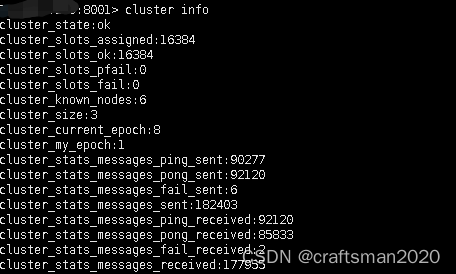三台机器搭建redis集群过程及问题记录
文章目录
-
-
- 1. 前言
- 2. 搭建集群
- 3. 遇到的问题
- 4. cluster指令
- 5. 相关文章
-
- (1) redis集群搭建
- (2) 华为云两台机器内网互联
- (3) /etc/rc.d/init.d 详解|程序开机自启
- (4) Redis5.0+ Redis集群水平扩容|节点删除
- (5) 三台机器搭建redis集群过程及问题记录
- (6) redis5.0集群搭建(两台服务器)
- (7) Linux安装部署Redis
- (8) 【redis】 windows环境下安装、配置、使用、卸载
- (9) CentOS chkconfig的安装及使用
- (10) 解决Linux局域网不能相互访问
- (11) redis集群中节点fail,noaddr
- (12) shell脚本使用字典
-
1. 前言
Redis版本 5.0.4
服务器版本 Linux CentOS 6;CentOS 7;CentOS 9;
redis集群需要至少要三个master节点,我们这里搭建三个master节点,并且给每个master再搭建一个slave节点,总共6个redis节点,三主三从。
2. 搭建集群
-
给三台机器都装上redis
Linux安装部署Redis
https://blog.csdn.net/craftsman2020/article/details/122851974 -
创建redis-cluster目录
分别在各个服务器下的redis安装目录下(/usr/local/redis/)创建redis-cluster目录
cd /usr/local/redis/
mkdir redis-cluster
在redis-cluster下分别创建8001,8002
cd /usr/local/redis/redis-cluster
mkdir 8001 8002
其他两台机器一样的操作,端口分别为8003 8004、 8005 8006
- 2.3 拷贝配置文件
将之前的redis.conf拷贝至8001目录
cp /usr/local/redis/redis.conf /usr/local/redis/redis-cluster/8001/
其他5个目录一样操作
- 修改redis.conf
1)daemonize yes
2)port 8001(分别对每个机器的端口号进行设置)
3)dir /usr/local/redis/redis-cluster/8001/(指定数据文件存放位置,必须要指定不同的目录位置,不然会丢失数据)
4)cluster-enabled yes(启动集群模式)
5)cluster-config-file nodes-8001.conf(集群节点信息文件,这里800x最好和port对应上)
6)cluster-node-timeout 5000
7) bind 127.0.0.1(去掉bind绑定访问ip信息, 注释掉,或改为0.0.0.0也可)
8) protected-mode no (关闭保护模式)
9)appendonly yes
如果要设置密码需要增加如下配置:
10)requirepass xxx (设置redis访问密码)
11)masterauth xxx (设置集群节点间访问密码,跟上面一致)
将修改好的8001的redis.conf配置文件分别拷贝至8002-8006,修改响应的端口,文件名
cp /usr/local/redis/redis-cluster/8001/redis.conf /usr/local/redis/redis-cluster/8002/
scp /usr/local/redis/redis-cluster/8001/redis.conf [email protected]:/usr/local/redis/redis-cluster/8003/
scp /usr/local/redis/redis-cluster/8001/redis.conf [email protected]:/usr/local/redis/redis-cluster/8004/
scp /usr/local/redis/redis-cluster/8001/redis.conf [email protected]:/usr/local/redis/redis-cluster/8005/
scp /usr/local/redis/redis-cluster/8001/redis.conf [email protected]:/usr/local/redis/redis-cluster/8006/
新拷贝的五个文件仅修改配置项:port、dir、cluster-config-file 即可
- 分别启动6个redis实例
redis-server /usr/local/redis/redis-cluster/8001/redis.conf
redis-server /usr/local/redis/redis-cluster/8002/redis.conf
redis-server /usr/local/redis/redis-cluster/8003/redis.conf
redis-server /usr/local/redis/redis-cluster/8004/redis.conf
redis-server /usr/local/redis/redis-cluster/8005/redis.conf
redis-server /usr/local/redis/redis-cluster/8006/redis.conf
- 创建集群
redis-cli -a 123456 --cluster create --cluster-replicas 1 192.168.2.58:8001 192.168.2.58:8002 192.168.2.59:8003 192.168.2.59:8004 192.168.1.60:8005 192.168.1.60:8006
- 验证集群
连接A机器任意一个节点
redis-cli -a 123456 -c -h 192.168.2.58 -p 8001 -a 123456
redis-cli -a 123456 -c -h 192.168.2.58 -p 8001 shutdown
redis-cli -a 123456 -c -h 192.168.2.58-p 8002 shutdown
redis-cli -a 123456 -c -h 192.168.2.59 -p 8003 shutdown
redis-cli -a 123456 -c -h 192.168.2.59 -p 8004 shutdown
redis-cli -a 123456 -c -h 192.168.1.60 -p 8005 shutdown
redis-cli -a 123456 -c -h 192.168.1.60 -p 8006 shutdown
- 用脚本关闭和启动集群
- 用脚本关闭集群
#!/bin/bash
#所有服务器节点的hostname
allnodes=('10.12.2.59' '10.12.2.58' '192.168.1.60')
local_ip=`ifconfig -a|grep inet|grep -v 127.0.0.1|grep -v inet6|awk '{print $2}'|tr -d "addr:"`
echo "### " date
echo "### local_ip: ${local_ip}"
PORT=8001
ENDPORT=8007
PASSWROD=123456
while [ $((PORT < ENDPORT)) != "0" ]; do
for ip in ${allnodes[@]};
do
if [ "$ip" = "$local_ip" ];
then
local_count=`ps -ef|grep redis |grep $PORT | wc -l`
if [ $local_count -gt 0 ];
then
echo "### Stoping Local Redis $ip:$PORT"
redis-cli -p $PORT -a $PASSWROD shutdown
else
echo "no Local redis $ip:$PORT"
fi
else
#判断某个端口是否已被占用,如果是,则执行关闭命令
count=`ssh root@$ip lsof -i:$PORT | wc -l`
if [ $count -gt 0 ];
then
echo "### Stopping Redis $ip:$PORT"
ssh root@$ip redis-cli -p $PORT -a $PASSWROD shutdown 2>/dev/null
else
echo "no redis $ip:$PORT"
fi
fi
done
PORT=$((PORT+1))
done
exit 0
- 用脚本启动集群
#!/bin/bash
#所有服务器节点的hostname
declare -A dic
dic=([8001]="10.12.2.58" [8002]="10.12.2.58" [8003]="10.12.2.59" [8004]="10.12.2.59" [8005]="192.168.1.60" [8006]="192.168.1.60")
local_ip=`ifconfig -a|grep inet|grep -v 127.0.0.1|grep -v inet6|awk '{print $2}'|tr -d "addr:"`
echo "### " date
echo "### local_ip: ${local_ip}"
for port in ${!dic[*]}
do
ip=${dic[${port}]}
#echo ip: ${ip} ${port}
if [ "$ip" = "$local_ip" ];
then
local_count=`ps -ef|grep redis |grep $port | wc -l`
if [ $local_count -eq 0 ];
then
echo "Start Local Redis Server $ip $port"
redis-server /usr/local/redis/redis-cluster/$port/redis.conf
else
echo "Local Redis Server $ip $port already exists!"
fi
else
count=`ssh root@$ip ps -ef|grep redis-server|grep -v grep|grep $port| wc -l`
if [ $count -eq 0 ];
then
echo "Start Redis Server $ip $port"
ssh root@$ip redis-server /usr/local/redis/redis-cluster/$port/redis.conf
else
echo "Redis Server $ip $port already exists!"
fi
fi
done
exit 0
注意:
- 各集群都设置开开机启动,设置方法请参考https://blog.csdn.net/craftsman2020/article/details/128130348?spm=1001.2014.3001.5502
- 为了方便启动和终止程序,用shell脚本操作。
- 集群各机器操作系统版本尽量协调,避免出现Centos6和Centos9无法ssh访问的问题。
3. 遇到的问题
- 三台机器设置免密互访
但由于这三台机器centos版本差异大,导致Centos9和Centos6无法设置免密互访。
设置免密报错,直接用ssh指令连接也会报错:

尝试在生成公钥的文件夹里(一般在当前用户目录下的.ssh文件中)创建一个config文件(没有后缀),用文本文档格式打开,添加下方内容
Host *
HostkeyAlgorithms +ssh-rsa
PubkeyAcceptedKeyTypes +ssh-rsa
参考:
https://blog.csdn.net/weixin_51443484/article/details/125944815
https://weibo.com/ttarticle/p/show?id=2309404806141325738316
但是并没有解决。
之后在centos6上对centos9设置免密:
ssh-copy-id -i ~/.ssh/id_rsa.pub [email protected]
报错如下:
no hostkey alg
在centos9上对centos6设置免密报错如下:
/usr/bin/ssh-copy-id: INFO: Source of key(s) to be installed: "/root/.ssh/id_rsa.pub"
/usr/bin/ssh-copy-id: INFO: attempting to log in with the new key(s), to filter out any that are already installed
/usr/bin/ssh-copy-id: ERROR: Unable to negotiate with 192.168.1.30 port 22: no matching host key type found. Their offer: ssh-rsa,ssh-dss
之后采取了折中的办法,因为Centos7可以对另外两台脚本互设免密,所以就把启动和终止redis集群的脚本放在了Centos7上。
- 连接redis集群报错:(error) MOVED的解决方法
./redis-cli -h 192.168.2.58 -p 8001-a 123456
192.168.2.58 :8001 > get name
(error) MOVED 5798 192.168.2.58 :8001
这种情况一般是因为启动 redis-cli 时没有设置集群模式所导致。
启动时使用 -c 参数来启动集群模式,命令如下:
./redis-cli -h 192.168.2.58 -p 8001 -a 123456 -c
192.168.2.58:8001 > get name
-> Redirected to slot [5798] located at 192.168.2.58 :8001
-
(error) READONLY You can‘t write against a read only replica.
出现以上错误,表示当前redis服务是只读的,没有写权限,估计该服务是被当作从数据库使用了。
当在redis集群的从节点上做写操作时会遇到以上报错。 -
Redis (error) CROSSSLOT Keys in request don’t hash to the same slot
参考 https://blog.csdn.net/TreeShu321/article/details/102766814
4. cluster指令
192.168.1.150:8007> cluster help
1) CLUSTER <subcommand> arg arg ... arg. Subcommands are:
2) ADDSLOTS <slot> [slot ...] -- Assign slots to current node.
3) BUMPEPOCH -- Advance the cluster config epoch.
4) COUNT-failure-reports <node-id> -- Return number of failure reports for <node-id>.
5) COUNTKEYSINSLOT <slot> - Return the number of keys in <slot>.
6) DELSLOTS <slot> [slot ...] -- Delete slots information from current node.
7) FAILOVER [force|takeover] -- Promote current replica node to being a master.
8) FORGET <node-id> -- Remove a node from the cluster.
9) GETKEYSINSLOT <slot> <count> -- Return key names stored by current node in a slot.
10) FLUSHSLOTS -- Delete current node own slots information.
11) INFO - Return onformation about the cluster.
12) KEYSLOT <key> -- Return the hash slot for <key>.
13) MEET <ip> <port> [bus-port] -- Connect nodes into a working cluster.
14) MYID -- Return the node id.
15) NODES -- Return cluster configuration seen by node. Output format:
16) <id> <ip:port> <flags> <master> <pings> <pongs> <epoch> <link> <slot> ... <slot>
17) REPLICATE <node-id> -- Configure current node as replica to <node-id>.
18) RESET [hard|soft] -- Reset current node (default: soft).
19) SET-config-epoch <epoch> - Set config epoch of current node.
20) SETSLOT <slot> (importing|migrating|stable|node <node-id>) -- Set slot state.
21) REPLICAS <node-id> -- Return <node-id> replicas.
22) SLOTS -- Return information about slots range mappings. Each range is made of:
23) start, end, master and replicas IP addresses, ports and ids
5. 相关文章
(1) redis集群搭建
redis集群搭建
(2) 华为云两台机器内网互联
华为云两台机器内网互联
(3) /etc/rc.d/init.d 详解|程序开机自启
/etc/rc.d/init.d 详解|程序开机自启
(4) Redis5.0+ Redis集群水平扩容|节点删除
Redis5.0+ Redis集群水平扩容|节点删除
(5) 三台机器搭建redis集群过程及问题记录
三台机器搭建redis集群过程及问题记录
(6) redis5.0集群搭建(两台服务器)
redis5.0集群搭建(两台服务器)
(7) Linux安装部署Redis
Linux安装部署Redis
(8) 【redis】 windows环境下安装、配置、使用、卸载
【redis】 windows环境下安装、配置、使用、卸载
(9) CentOS chkconfig的安装及使用
CentOS chkconfig的安装及使用
(10) 解决Linux局域网不能相互访问
解决Linux局域网不能相互访问
(11) redis集群中节点fail,noaddr
redis集群中节点fail,noaddr
(12) shell脚本使用字典
shell脚本使用字典


